GuitarPlayer Verdict
Epiphone’s 1958 Korina Flying V and Explorer are both well-built and great-playing homages to these iconic models that are reasonably priced for what they deliver
Pros
- +
1958 Korina Flying V: An impressively accurate take on the 1958 Flying V at its price point, delivering surprisingly versatile tones and great playability
- +
1958 Korina Explorer: An impressively accurate take on the 1958 Explorer at its price point, presenting thick, rich, yet expressive tones and excellent playability
Cons
- -
1958 Korina Flying V: None that the original design doesn’t present. Might have been nice to see it in a gloss finish.
- -
1958 Korina Explorer: Again, might have been nice to see it in a gloss finish
You can trust Guitar Player.
When Gibson unveiled the Flying V and Explorer in its Modernist Series in 1958, their radical designs quickly proved the very definition of “ahead of their time.” Gibson president Ted McCarty and his team concocted the sharp angles and space-age looks to conquer the rock and roll revolution, but not too many notable artists were bold enough to embrace the daring styles, and relatively few were sold before the models were deleted from the catalog after 1960.
Today, most see these Modernist designs as having been aimed at musical styles that were yet to be born. After the Flying V’s 1967 reissue (and further iterations that followed in the ’70s), and the Explorer’s 1976 re-introduction after rock-leaning competitors began adopting the shape, these models quickly secured their iconic status in heavy rock and metal and have remained hotly in demand ever since.
Rarely, however, have they been available in anything close to the original specs, other than via the occasional runs from the Gibson Custom Shop. Usually built from mahogany or woods other than the korina of the 1958-’60 series, and often with other altered specs and appointments, the majority of the reinventions have honored the shapes of the originals while rarely capturing the full essence of the revolutionary 1958 guitars.
That’s the void that the Epiphone Inspired by Gibson 1958 Korina Flying V and Explorer seek to fill as closely as possible, given their accessible price point. And at first glance, each certainly nails the appearance and overall vibe of the Gibson originals, using the correct body woods, accurate-looking hardware and plastics, and more.
But hold on: Haven’t most Epiphones been inspired by Gibson models since the Kalamazoo maker acquired its New York City rival in 1957? Yes, but by name-checking its parent company in this recent series Epiphone is signaling the partnership with the acclaimed Gibson Custom Shop that has helped to bring improved accuracy and overall quality to guitars sold under the “Inspired by” banner.
Manufactured by Epiphone’s facility in China, the 1958 Korina Flying V and Explorer are nevertheless designed and spec’ed-out in conjunction with Gibson’s Custom Shop in Nashville, and the joint logo on the back of the headstock ensures that level of accuracy and quality.
Putting korina right in the guitars’ names further emphasizes just how important this choice of wood is considered to be. Generically known as white limba, korina is thought of as a cousin to mahogany, although it’s lighter in color and often lighter in weight. In addition, it presents its own sonic signature that is relatively well balanced but distinctive, with a sizzling presence in the upper midrange and a textured chewiness in the harmonic content.
On both models, this korina is finished in a color Epiphone calls Vintage Natural, using a process referred to as aged gloss, but which most players would call satin. It works well for the general impression of each, although I think a fully buffed-out gloss finish would have looked great on these guitars.
They have Burstbucker 2 and 3 (rhythm and lead) PAF-style humbuckers wired to independent volume controls and master tone controls
The Epiphone 1958 Korina Flying V and Explorer have other specs and features in common. Both are available with either white or black multi-ply pickguards, as were the originals (the white version is reviewed here), with gold-plated hardware on all renditions.
They have Burstbucker 2 and 3 (rhythm and lead) PAF-style humbuckers wired to independent volume controls and master tone controls. Pots are by CTS, with a Mallory tone capacitor and Switchcraft toggle selector and jack, and both have unbound fingerboards made from Indian laurel, a sustainable medium-brown hardwood that nicely approximates rosewood.
Both also have accurate ’58 neck profiles that are full and comfortably rounded – a meaty handful that I really dig, and which you don’t often find on guitars of this level.
1958 KORINA FLYING V
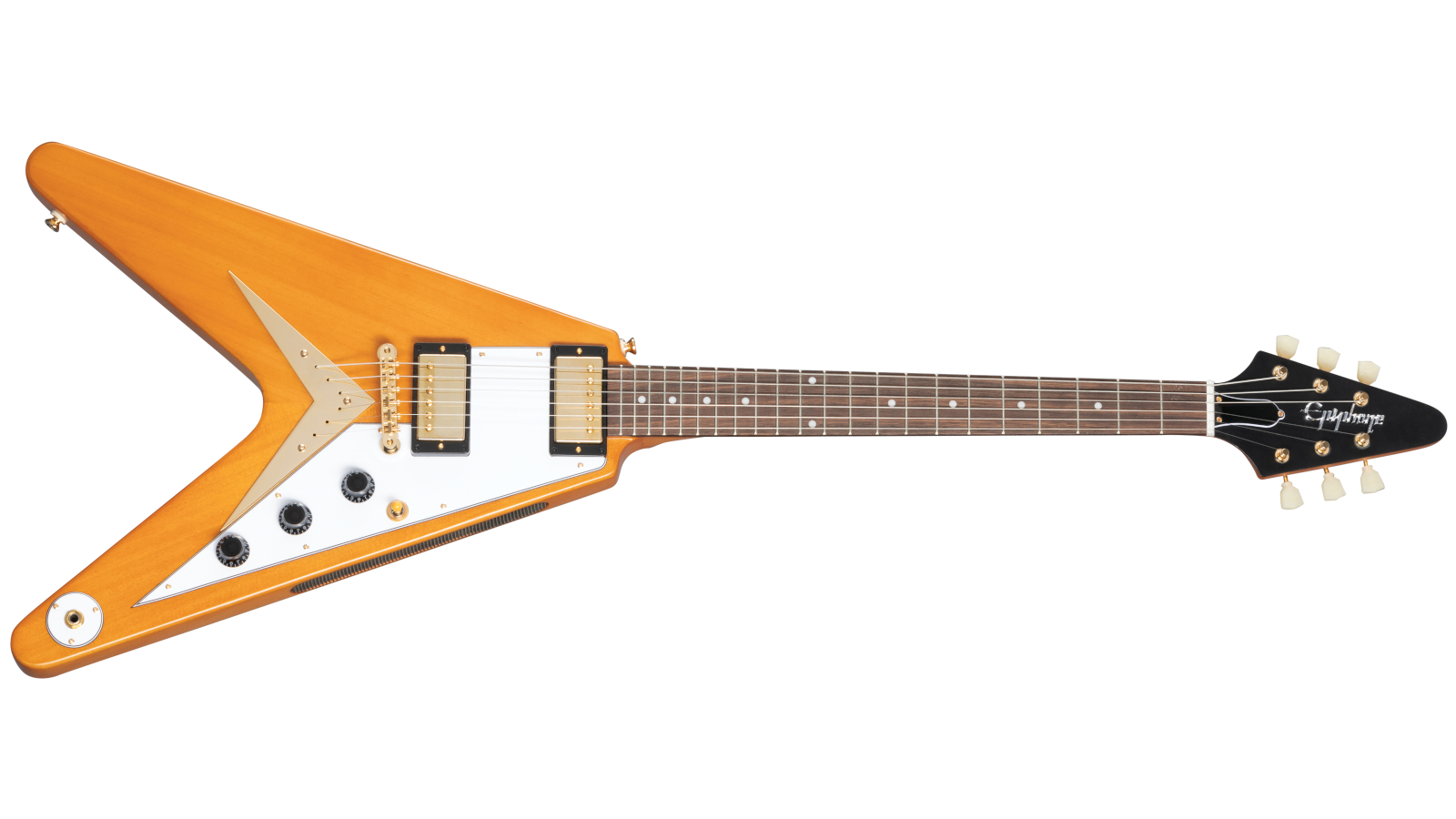
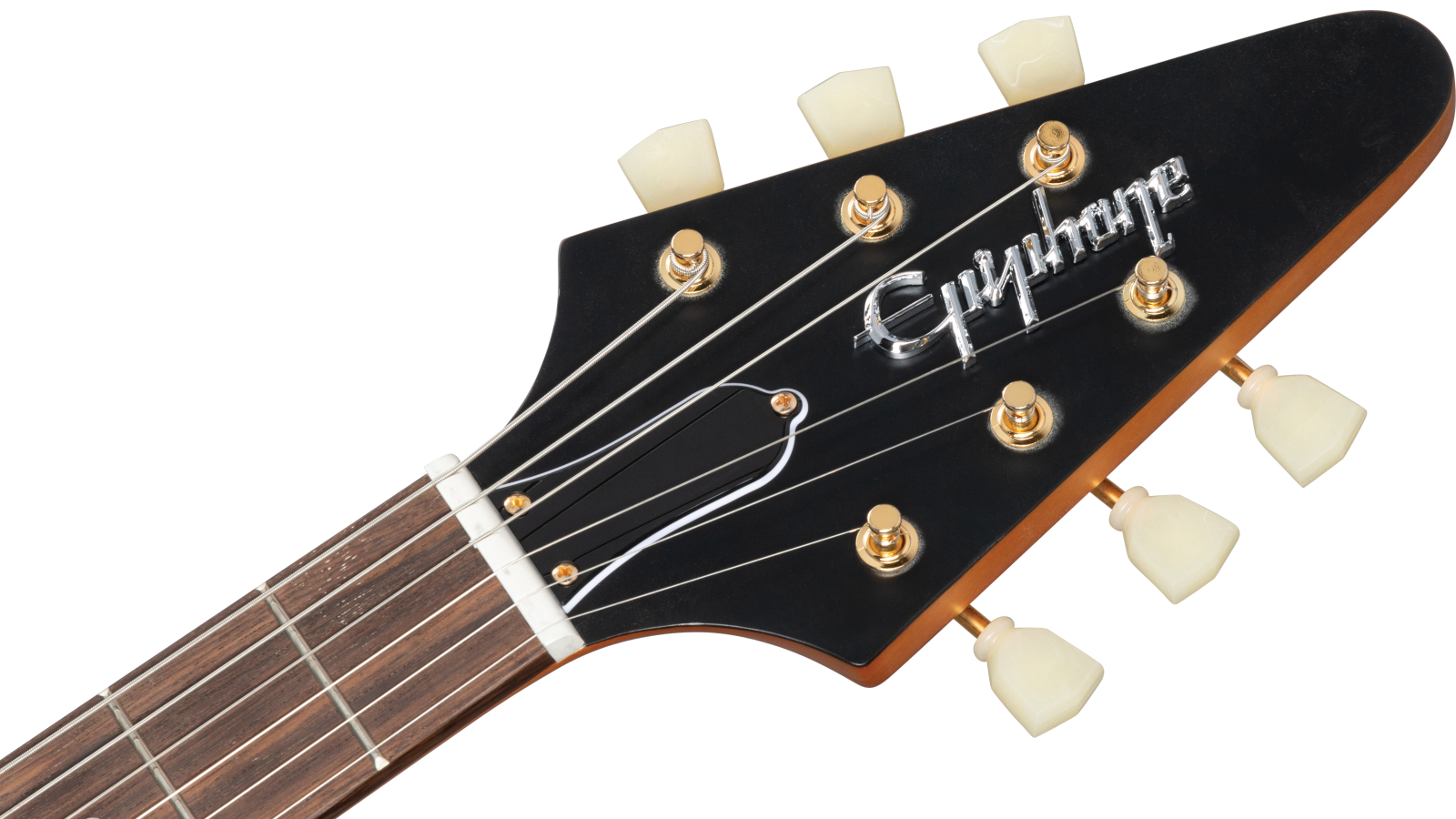
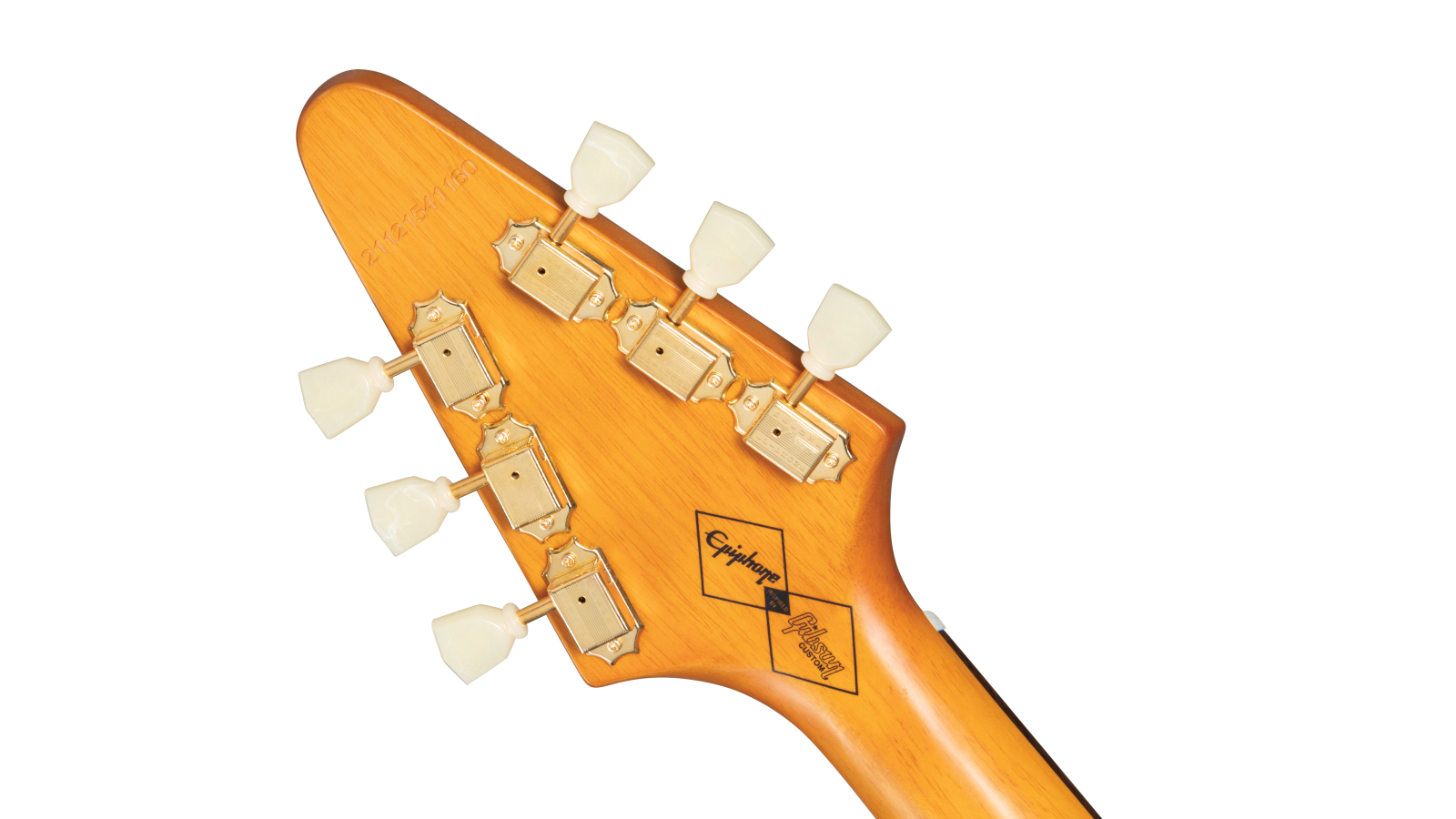
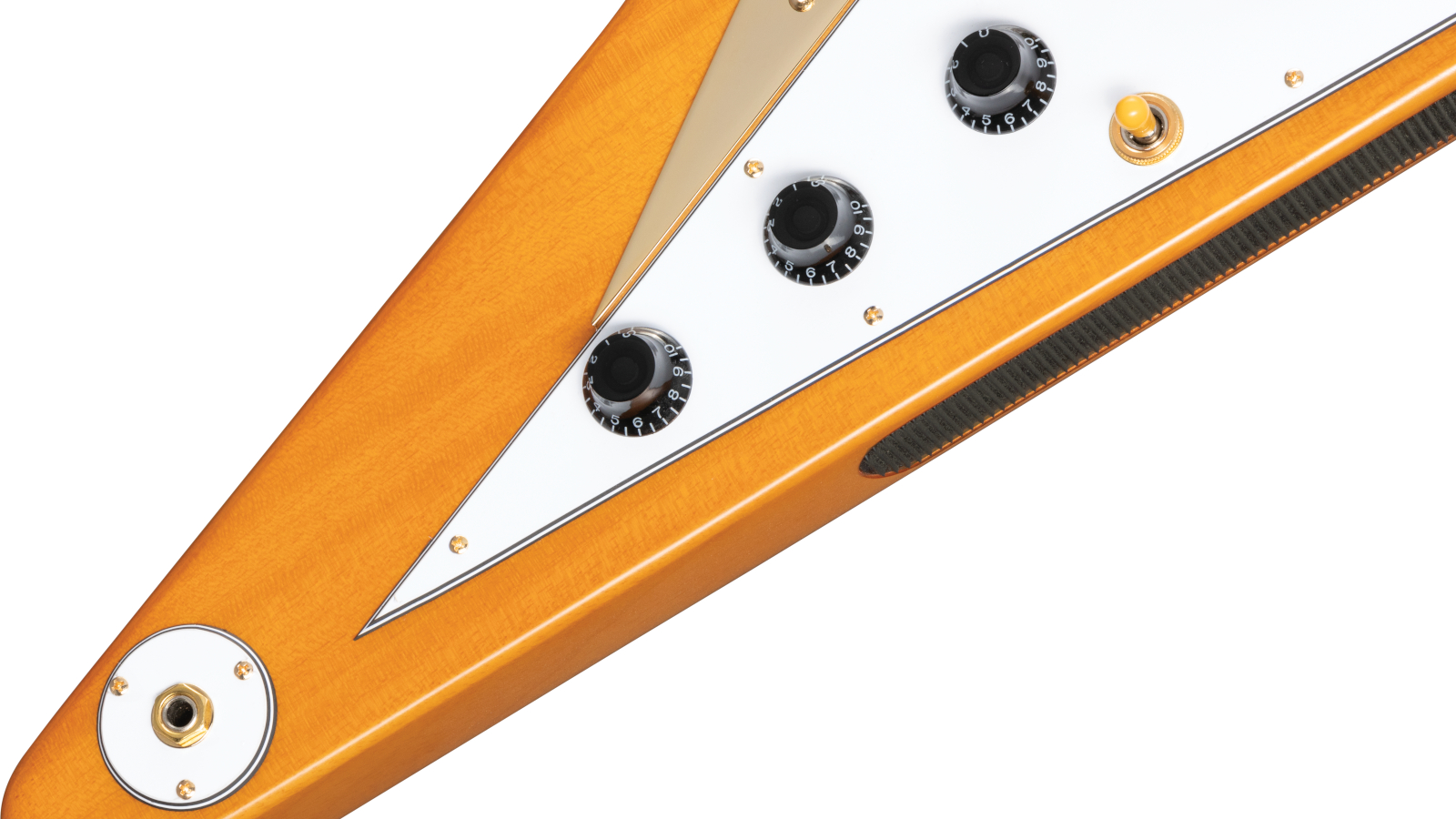
It’s hard not to think “heavy rock” when a Flying V comes out, and the style certainly became a badge of honor for many players rocking spandex, full stacks and poodle hair. But there’s also something raw and rustic about a circa-’58 Korina V that reminds you they were applied to great blues and roots stylings by Albert King and Lonnie Mack, as well as classic Brit-rock by Keith Richards, Dave Davies and others. Either way, however, it steers me more toward garage rock than metal, although the design is more versatile than might first be expected.
Rather than just being the same wood in different shapes, the Korina Flying V and Explorer present subtle but significant alterations – both from each other, and from more standard guitars – that help form their sonic characters.
The neck tenon on each is quite deep, to enable the high neck/body joints, and the V shakes it up further with Tele-like through-body stringing, bringing the ferules, the body wood and the brass “V” tail plate into play. Otherwise, Flying Vs are always challenging to play on the lap, and this one’s no different. The rubber skid-mat inlaid into the thigh-side edge helps a little. Strap it up, though, and it’s game on.
This 1958 Korina Flying V is surprisingly expressive, perhaps more so than you’d expect
Tested through a Friedman Smallbox amp head and 2x12 cab, a custom 5E3-style 1x12 combo, and a Neural DSP Quad Cortex into the studio monitors, the Korina 1958 Flying V quickly expressed the boatload of sonic personality that has long made this design far more than just a funky shape.
The combination of the light korina and through-body stringing, alongside the PAF-inspired pickup choice and the wood’s own sonic characteristics, delivers a blend of midrange snarl and harmonic complexity – yet with a certain scooped airiness at its core – that works for more nuanced styles as well as it does for straight-up rock and roll.
It’s a lively, resonant guitar overall, and while a high-gain pedal easily helps it get heavy, this 1958 Korina Flying V is surprisingly expressive, perhaps more so than you’d expect, given the all-in style choice that its shape represents.
Specifications
- NUT: GraphTech, 1.692” wide
- NECK: Korina, ’58 Flying V (deep-C) profile
- FRETBOARD: Indian laurel, 24.75” scale, 12” radius
- FRETS: 22 medium-jumbo
- TUNERS: Epiphone Deluxe with push-in bushings
- BODY: Solid korina
- BRIDGE: ABR-1 Tune-o-matic and through-body stringing with brass “V” plate, gold plated
- PICKUPS: Gibson Burstbucker 2 rhythm, Burstbucker 3 lead
- CONTROLS: Two volume controls, master tone control, three-way selector switch
- FACTORY STRINGS: Gibson Brite Wire .010–.046
- WEIGHT: 7.1 lbs
- BUILT: China
1958 KORINA EXPLORER
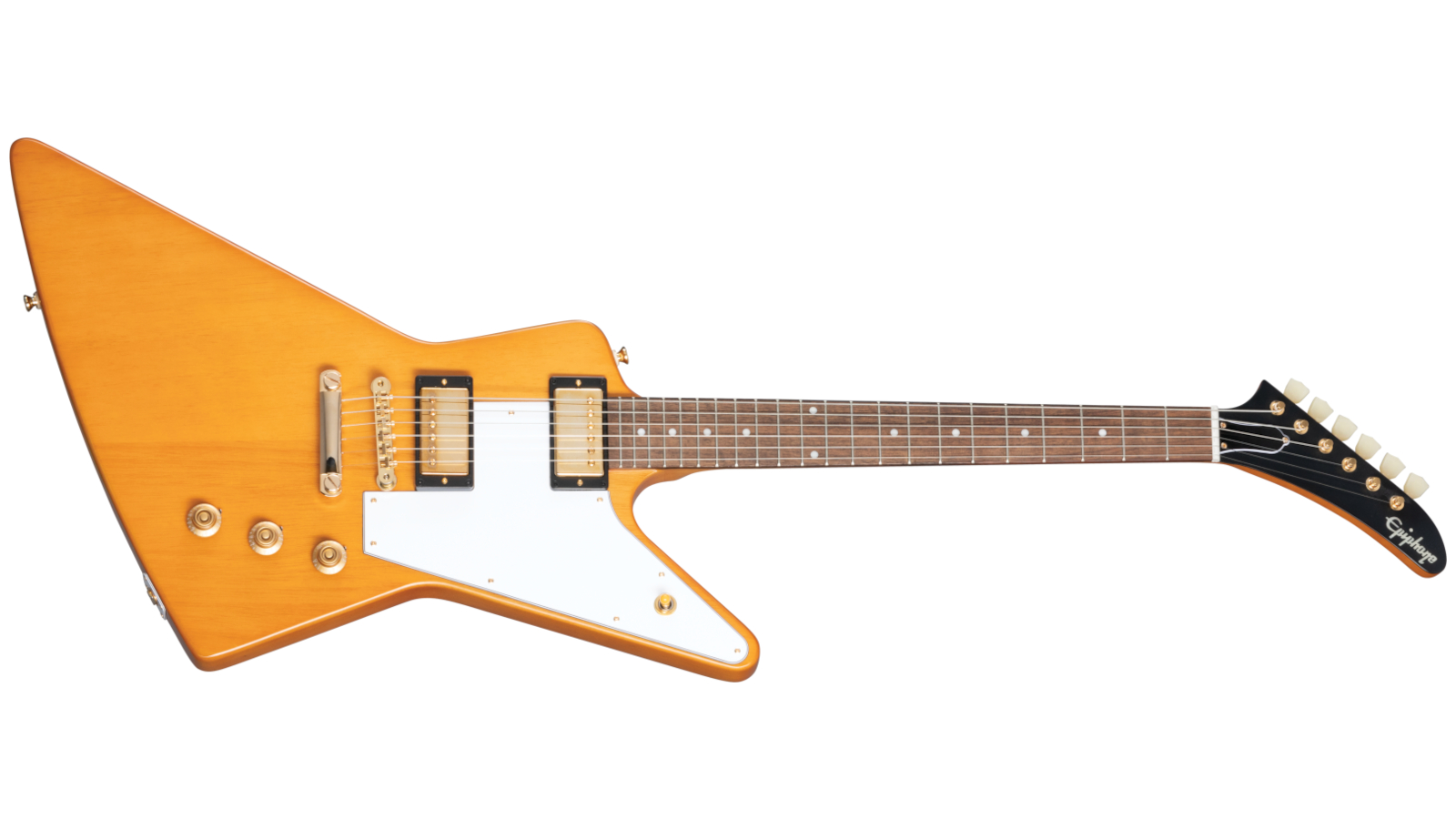
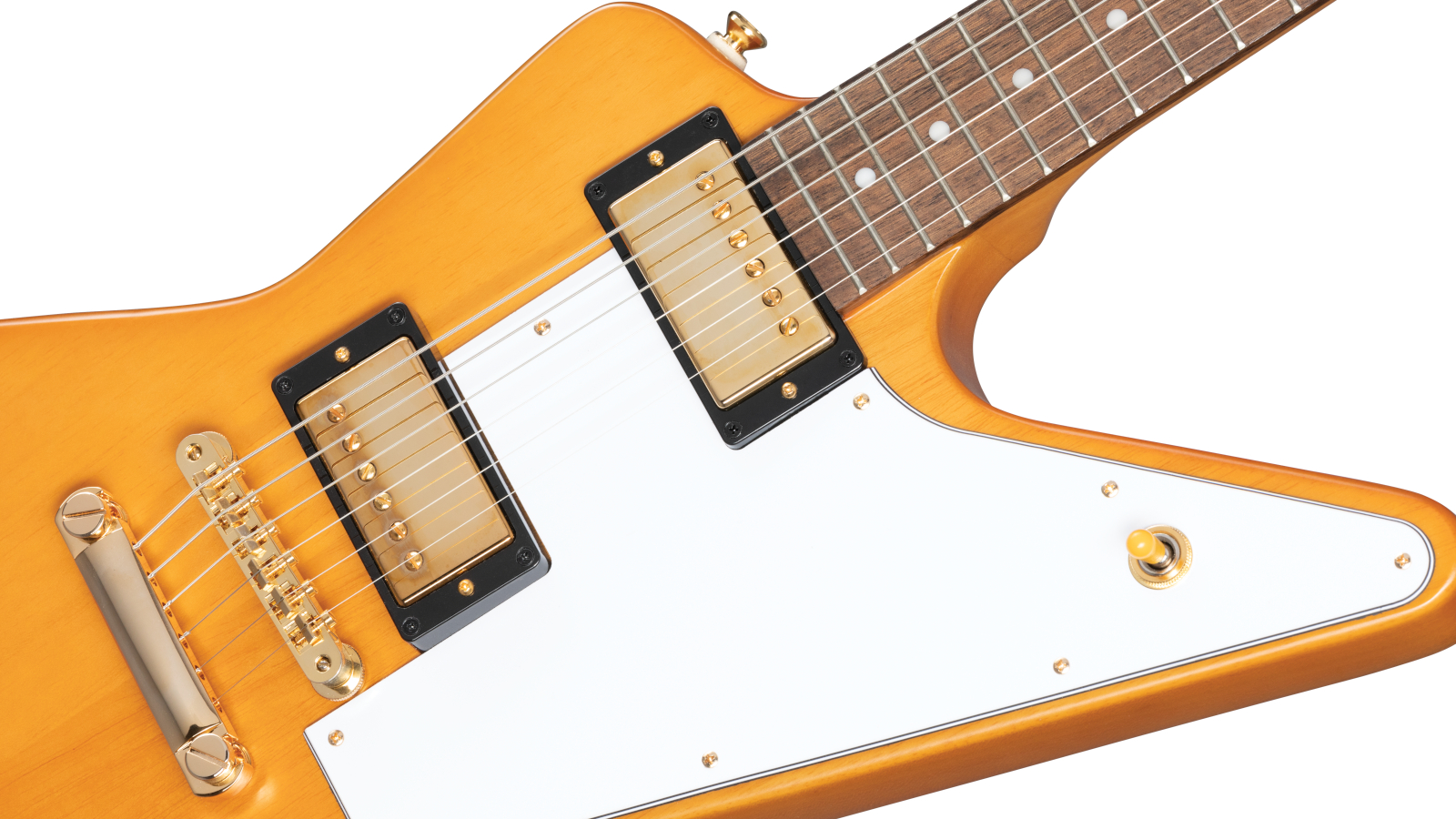


While a good 95 percent of what’s been said about the Flying V goes for the 1958 Korina Explorer, the aesthetics of the different body shape, the six-a-side headstock and the use of a stop-bar tailpiece, rather than through-body stringing, account for the significant differences.
The former means you can play this one while seated without constantly fighting to keep it from crashing to the floor, but the reconfiguration of that wood (and the use of a little more of it) also changes the guitar’s resonant characteristics and its fundamental tones.
Played through the same test rigs as the Flying V, the Explorer reveals a little more body in the low end and slightly more thickness in the mids, while retaining the chewy, swirly overtones and high-end bite that helped give the Flying V its sonic personality.
The Burstbucker pickups did well into an Angry Charlie distortion or a Blackout Effectors Musket fuzz for classic metal tones, while the Explorer dials back easily into more nuanced blues or power-pop voicings, proving itself surprisingly versatile.
Specifications
- NUT: GraphTech, 1.692” wide
- NECK: Korina, ’58 Explorer (deep-C) profile
- FRETBOARD: Indian laurel, 24.75” scale, 12” radius
- FRETS: 22 medium-jumbo
- TUNERS: Epiphone Deluxe with push-in bushings
- BODY: Solid korina
- BRIDGE: ABR-1 Tune-o-magic and stopbar tailpiece, gold plated PICKUPS Gibson Burstbucker 2 rhythm, Burstbucker 3 lead
- CONTROLS: Two volume controls, master tone control, three-way selector switch
- FACTORY STRINGS: Gibson Brite Wire .010–.046
- WEIGHT: 7.3 lbs
- BUILT: China
CONCLUSION
One of the main takeaways here is perhaps the same one the originals delivered in 1958: These are surprisingly adaptable and expressive designs, so don’t let their radical looks lead you astray.
Epiphone’s 1958 Korina Flying V and Explorer are both well-built and great-playing homages to these iconic models that are reasonably priced for what they deliver, and each is deserving of an Editors’ Pick Award.
Visite Epiphone for more information.
Dave Hunter is a writer and consulting editor for Guitar Player magazine. His prolific output as author includes Fender 75 Years, The Guitar Amp Handbook, The British Amp Invasion, Ultimate Star Guitars, Guitar Effects Pedals, The Guitar Pickup Handbook, The Fender Telecaster and several other titles. Hunter is a former editor of The Guitar Magazine (UK), and a contributor to Vintage Guitar, Premier Guitar, The Connoisseur and other publications. A contributing essayist to the United States Library of Congress National Recording Preservation Board’s Permanent Archive, he lives in Kittery, ME, with his wife and their two children and fronts the bands A Different Engine and The Stereo Field.
"It's a powerful, versatile variation on the timeless Telecaster, with a vital back story to boot." We review the Fender Stories Collection Mike Campbell Red Dog Telecaster
"We tried every guitar for weeks, and nothing would fit. And then, one day, we pulled this out." Mike Campbell on his "Red Dog" Telecaster, the guitar behind Tom Petty & the Heartbreakers' "Refugee" and the focus of two new Fender tribute models












